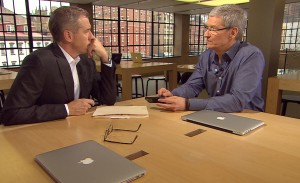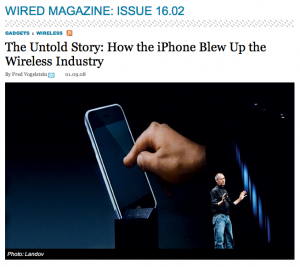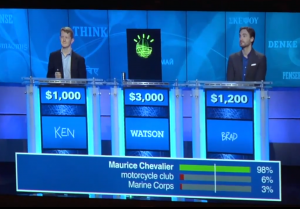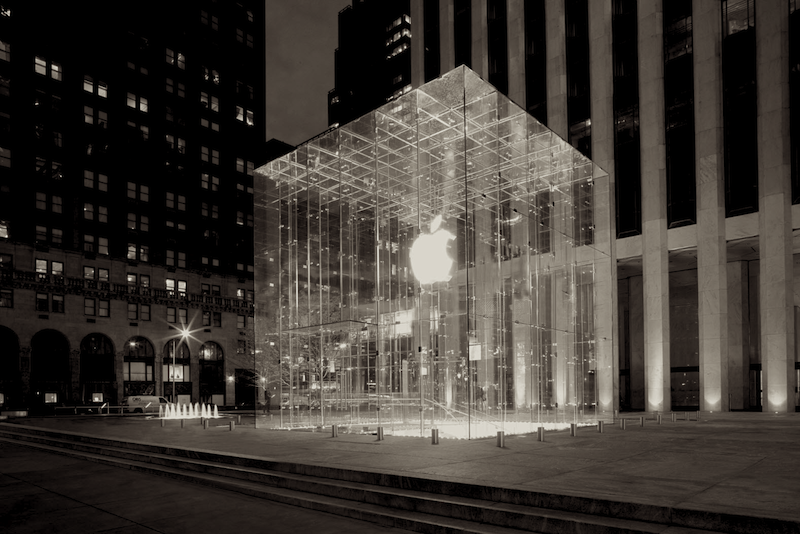
The Apple Store on Fifth Avenue.
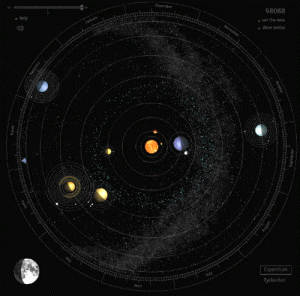
Our Solar System – Eight planets circling a fixed luminous point.
orbit
noun \ˈȯr-bət\
1: a path described by one body in its revolution about another (as by the earth about the sun or by an electron about an atomic nucleus); also : one complete revolution of a body describing such a path
2: a range or sphere of activity or influence
Latin orbita
first known use: 1696
examples:
the earth orbits the sun.
the moon (and satellites) orbit the earth.
Apple is Busy Building a Star
In March of 2012, we covered many of the product development and supply chain indicators which lead us to believe that Apple plans to tackle television in a much grander way than the market currently envisions. Take a peek at Apple Televisions Are Coming in 2013…, as the vast majority of insight stood the test of time. However, a few areas have continued to shift over time. Now, we would like to leverage the detail of our original article and add new context to continue to shape a vision for what may be next from Apple. For as we see it right now, the center point of the Smart Home will most likely be next big domino to fall in the consumer-electronics ecosystem. Televisions will likely be just one element of the overall effort.
““The TV was invented as a receiving device. But now it’s a display in the home. We must think, ‘How can we utilize it as part of a residential space?’” – Kazuhiro Tsuga, Panasonic CEO
Most people and households in the US have built their lifestyle around the Internet and slowly, but surely, the Internet of Things. Over the past 15 years the technical needs of consumers and the technical possibilities of the home, have matured. Home Automation technology, which was once costly to create (typically in a Windows OS framework) and then deploy throughout the home, has streamlined. Gone is the need for wires. Gone is the need for discrete and disparate electronics components which do not integrate easily. And if these systems are not gone by now, then they’re certainly exiting stage left. With recent advances in tech, there are just easier ways to service this need now.
Tech-friendly and tech-synchronized homes have become increasingly important to people and homeowners–probably even more than average consumers grasp today–and Apple has an opportunity to satisfy this need in a very real and cost effective way. All users need is a data-ready home, which most of us have, and a single backbone device that can act as a star, of sorts… anchoring all of the connected devices (smartphones, tablets, televisions/monitors) in its orbit, or sphere of influence. Whether users are inside, outside or traveling in another city, such a Smart Home device would revolutionize how people interact with their residences and other members of their household.
Yes. Signs are now pointing to a new Apple Smart Home system which will be much more sophisticated than simply a highly-impressive interactive television. We believe that Apple is, in essence, creating a new centralized computing appliance which will anchor all of the digital interactions of a residence. And such a Smart Home device would open up the possibility for an entirely new ecosystem for partners/vendors to service and industrialize. Now, we know that these are big statements… so let us share a few areas of research that are helping to pull the strategy lens into focus:
- Interesting patent applications filed by Apple over the past 12 months
- The rise of the Bluetooth 4.0 wireless tech standards
- Wireless TV screens by Sharp (an Apple monitor partner)
- Skyrocketing adopting of connected devices and mobile services (apps) – Cisco VNI 2013
- Plummeting PC sales and television sales
- Apple’s own language (more to come in this article)
- Wall Street’s language
Killer OS, Killer Devices and Killer Media Access – aka the Trifecta of Tech
If you visited CES this year or stopped-by any large electronics retailer over Christmas, you’ll know that consumer electronics sales have continued to decline and all traditional manufacturers and electronics retailers are in panic mode. Best Buy stores are flooded with electronics, but store activity is relatively quiet when compared to that of Apple stores; which are brimming with people, curiosity and high-value sales. The Apple zeitgeist shows no signs of slowing down. At CES this year, many items seemed to rely heavily on the digital device ecosystems of Amazon, Apple or Google. Televisions themselves reaching a technical specification zenith (4K and 8k), which is well-beyond the average customer’s needs and beyond the broadcasting capabilities of most networks.
“It’s a very bitter pill to swallow for manufacturers, but the device is no longer the centre of the digital universe… Now consumers’ digital relationship is with the platform and content, whether it’s iTunes or Google Play or Amazon, and that relationship dictates the devices that interest them.” – James McQuivey, Forrester Research
The following two industry articles provide a decent state of the union of the electronics industry. The first article is good in that it addresses how consumer electronics are turning into tech clutter. However, the latter article is the best, because Ms. Goode discusses how all roadsigns point to convergence and machine-to-machine (M-to-M) communications within the home.
- The trouble with CES: too much electronics, not enough consumer – Ed Bott, ZDNet
- CES 2013: The Year the “Connected Home” Becomes a Reality? – Lauren Goode, AllThingsD
Electronics manufacturers are running out of fresh ideas. Their device and computing platform expertise is decades behind that of Apple and others. Apple’s operating systems, digital devices and lifestyle ecosystem, which is the ultimate Tech Trifecta, has slowly evolved over 40 years. No other consumer electronics company to-date has simultaneously satisfied all three requirements of the Tech Trifecta as well as Apple–nor have other companies championed or defined entirely new digital categories as well as Apple. That said, Samsung is certainly inching closer to the Tech Trifecta campfire. However, Apple is destined to lead the new Smart Home category.
The Art of Creating a Demand Vacuum – aka The Willy Wonka Effect
Over the past several years, device internals matured (think yearly incremental improvements to microprocessors), while device form factors exploded with enhancements and optimization. The computing experience was melted-down and miniaturized to fit the inside of a pocket or pouch; touch-sensitive glass improved, connectivity increased (better cellular company grids) and device ecosystems matured. Some devices even disappeared, because software and connectivity usurped older device tasks (CD players). And because of all of this intense focus over the past five years, most consumers now have incredible small devices.
Well-equiped with these smaller connected devices and touchscreen-trained, consumer tech appetite has evolved and consumers are interested in something new, something more (it literally is starting to feel like hostile demand)–and this something new needs to be bigger than anything seen before. Currently, the largest piece of electronics in most US homes is the television. However, since the economic downturn of 2008, television revenues have been depressed by lack of demand, product saturation, competitive pricing and over capacity at the plant. Most people have great flat panel TVs (probably a couple of them and probably acquired pre-2008). Therefore, it’s doubtful that people really need another non-smart or smart-ish TV.
Then, this interview with Tim Cook airs…
If you missed Mr. Cook’s interview with Brian Williams on Rock Center, you should watch it in its entirety. It was a fantastic interview. Once you’re finished, you’ll probably agree with us when we note that whenever Tim Cook is asked about new Apple TV products, he rarely speaks of television alone, but instead refers to the “living room.” And this is usually behind a difficult-to-hide and generous smile. If he was trying to channel Steve Jobs in his first nationally-televised interview, he succeeded, because Cook essentially delivered “The Willy Wonka Effect.” And The Willy Wonka Effect, when used wisely, typically creates a massive buildup of demand.
Here are Mr. Cook’s key notes:
- He vows to always keep Apple cutting edge
- Apple is dedicated to making the world’s best products and enriching people’s lives
- Television is an area of intense interest
- When I go into my living room and turn on the TV, I feel like I have gone backwards in time by 20 to 30 years
- TV is a market that has been left behind
- Our whole role in life is to give you something that you didn’t know you wanted. And then once you get it, you can’t imagine your life without it
Steve Jobs, the tech-incarnate of Willy Wonka, first spoke of the iPhone at Macworld in January, 2007, approximately six months before the iPhone’s release. The impact of his words caused a massive mobile phone device sales halt, creating a sales vacuum that allowed the iPhone sales to explode once the iPhone was finally released. The product introduction details are fascinating to read, even to this day. You can relive the entire experience in the Wired article to the right. Mr. Cook just created a similar demand vacuum.
Content Kingdoms
Much in the same way that the iPhone disrupted the wireless industry, the cable and broadcast industries are about to be forcibly coerced into altogether new business models. It won’t happen overnight, but within the next five years the television industry, as you know it today, will look vastly different. No longer will cable carriers control customers by telling them what channel package tiers they can select. In the future, customers will probably keep a simple network package, but all other content will be purchased a la carte, directly from content producers/networks.
Enabled by new and better Smart Home devices that usurp the value and control of the cable box, consumers will finally command ultimate control over their home content. This will cause great programming to rise to the top and lesser programming to die off. Gone will be the filler content that rides the coattails of the cable package subscription model… much like how the iPhone put a stop to endless handset confusion in the wireless industry by eliminating any demand for lackluster handsets.
This is why today, we witness large cable systems buying networks. Content is King, so large cable providers are now acquiring the Content Kingdoms.
But the Fixed Luminous Point Will Be Much More Than a TV
Similar to how a sun (or star) anchors each of the orbiting planets within its sphere of influence (gravitational field), all ecosystems need a center mass. Today, there are hundreds of millions of iOS devices in circulation. Most homes have multiple Apple devices–iPhones, Macs, iPads and iPods. And while these devices can all connect to each other, they also represent an entire ecosystem which is without a center mass. Therefore, we believe that any new residential device from Apple will likely work very hard to anchor all of your smaller connected devices and act as a backbone (private network) for the entire Smart Home… whether you knew you needed that or not. Please take a peek here, Apple wants to create iPhone-based automated homes. While the article is nice, the reality is that the patent filing has much more to do with the interoperability of a centrally-connected home using paired devices to control the digital inputs and outputs of a residence.
In the past, humans wanted machines that made our lives easier by doing things for us–and we achieved in creating many of those machines. Now, humans want software to make our lives easier by simplifying and automating our tasks for us. Consumers really want smart and have an expectation of smart. And to be smart, products will have to have a high-level of cognitive function, as well as a sophisticated system for receiving user inputs/requests and then providing the user with outputs/results. The earliest explorations and incarnations of Apple’s Siri product will eventually mature and provide us with a more sentient concierge personality that’s very similar to HAL9000 of sci-fi fame. Now, that will be years away, but Siri and IBM’s Watson are certainly on such a trajectory. Watch the Jeopardy clip to the right. Competing at this level was a massive leap in tech, software and machine logic.
As people have switched to portable connected digital devices, computer sales have declined. We may still use our home computers for work or to sync our smaller connected devices, but the new devices themselves have evolved in such a way that they really feel like they now need a more suitable parent device in the home. Perhaps the center of interaction will be more commercial-grade and elegant than just another small, black set-top box. We envision a larger network appliance (probably closet based) which is wirelessly feed throughout the house. This appliance would connect the home to its resident devices and start to deliver on Home Automation.
Furthermore, it does not make sense that this new tech would be tied to a single interactive television. That would be too limiting–and it certainly feels less strategic. As Kazuhiro Tsuga, Panasonic CEO, reflected earlier, televisions themselves have morphed from receiving devices to displays. Instead, we believe that any Smart Home product from Apple will have the capacity to drive multiple monitors via wireless BlueTooth 4.0 tech and that each of those monitors will act as a direct input/output device for that particular location in the home.
Again, the device we see crystalizing is a larger, commercial-grade residential device that will act as the hub for home information sharing, interaction and management; allowing us a greater level of digital integration with our homes and the devices within our homes. Based on Wall Street’s demands/needs, this is a product line which could easily create a new $1 trillion line of business for Apple. And while the Android platform has provided Google (and Samsung) with a certain level of competitive success in the smartphone and connected device space, Google and Samsung have no experience with the type of Operating System that a large Smart Home appliance would require. Microsoft, well, of course, they do not make hardware–and, honestly, they’re not even really great at OS development, which is why people typically flock to Apple. Much like the iPhone and iPad, Apple has the opportunity to define and own this space.
Home Automation
For the better part of the last 15 years, mainstream electronics brands and custom audio/video companies have tried to crack the code on integrated-home devices. Some even came close. However, most of the devices remain kludgy at best, usually rely on the Windows OS and have no accompanying digital lifestyle ecosystem or family of devices in tow. Furthermore, most of these systems are created as stand-alone systems which are primarily focused on home entertainment and media–and leave the rest of the home off the table. Yes, some systems could dim lights or lower blinds, but that delivers only a very small portion of the overall Smart Home potential. And because these systems tend to be very custom, there is no legion of tech manufacturers laying in wait; ready and willing to blindly dive into the yet-to-truly-crystalize Smart Home market to create “new things.” Now, the tide is turning.
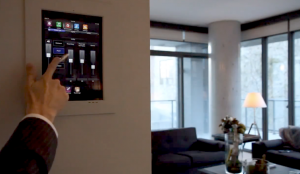
Savant Home Automation Solutions
Please review the following home automation products and systems:
- Nest – Residential – designed by Tony Fadell, Apple’s project lead on the iPod and iPhone from 2001-2009
- Savant – Residential – now utilizes the Apple OS, but the UX is clunky
- Crestron – Residential and Commercial – totally custom Crestron OS that they’re now having to port to iOS
In the future, our homes will be automated via an army of modular connected-devices that are paired with centralized Smart Home systems to perform particular monitoring and management tasks. The BlueTooth 4.0 standard was specifically created with this type of device pairing in mind. BT4’s first manifestations are visible in this year’s lineup of consumer wearable devices–think running bracelets which come with companion apps and utilize your iPhone’s BT4 connectivity for device-to-app synchronization. Or, Google Glass. BT4 can interconnect devices from as far as 150 feet away, while using very little power. This same tech which will blossom in your home.
New Smart Home systems will simplify, condense and manage all of the following technologies via applications. As you can imagine, an entirely new industry is about to open up for consumers:
- Device telematics and control (think energy management, HVAC, fire and security, lighting, medical device monitoring, irrigation, etc.)
- Communication – Internal and External (think intercom, VoIP telephone, large-screen FaceTime, cutting your landline telephone service for good)
- Entertainment – Television, Movies, Music and Games (think whole-home monitoring with multiple screens outlets, potentially cutting ties with cable channel providers for good)
If you need further proof of movement in this space, please review the following article which covers a recent Home Automation company acquisition by Microsoft. (1/10/13)
We’re still hoping to see our first glimpse of an Apple Television by Christmas 2013, but clearly, as illustrated by the length of this article, there is much more at stake. As a brand professional, you should continue to fine-tune your company’s connected-device strategies to ensure that you are well-positioned to take advantage of these new systems. You should research and determine ways to push your online brand assets and connected-device applications further and broader. Additionally, does your product have a Smart Home management/control hook for the home?
We’re still recommending sandbox exploration now, so that you can be an early adopter and ensure early success for your brand.
// Christopher Jones

